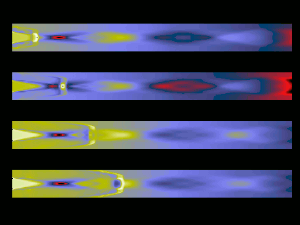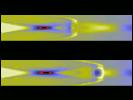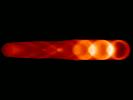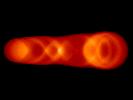
Dr. Jose L. Gomez and Prof. Alan P. Marscher
Department of Astronomy
Boston University
Dr. Jose M. Marti and Prof. Jose M. Ibanez
Departamento de Astronomia y Astrofisica
Universidad de Valencia
Spain
Dr. A. Alberdi
Instituto de Astrofisica de Andalucia (CSIC)
Spain
These images represent simulations of the gas dynamics and emission of synchrotron radiation at radio wavelengths in jets of energetic plasma often found in the core of quasars. Quasars lie near the edge of the observable Universe and are it’s most energetic objects. The material in these jets flows outward at velocities near the speed of light.
The hydrodynamic calculations were done by solving the relativistic conservation equations of rest-mass, momentum, and total energy for a perfect fluid with an approximate Riemann solver. The spatial accuracy is set by a conservative monotonic piecewise-parabolic interpolation. The emission is obtained by integrating the transfer equations for the synchrotron radiation within the jet, taking into account all the relativistic effects associated with its high velocity.
These simulations are of special importance to the understanding of the physics involved in the jets of Active Galactic Nuclei (quasars), and their environments. They provide the necessary information for interpreting observations of incoming high resolution radio interferometric data.
Further reading:
- Gomez et al, 1995. The Astrophysical Journal, volume 449, page L19
- Marti et al, 1995. The Astrophysical Journal, volume 448, page L105
Video Sequences

Video Sequence
This visualization shows the evolution of the Lorentz factor, logarithm of pressure, and logarithm of the specific internal energy for a jet with a perturbation in the velocity at the injection position.

Video Sequence
This visualization shows the radio map obtained from the previous gas dynamics simulations for a viewing angle of 10 degrees.

Video Sequence
This visualization shows the radio map obtained from the previous gas dynamics simulations for a viewing angle of 05 degrees.
More information on Quasars from the Space Telescope Electronic Information Service:
- Surprising Hubble Images Challenge Quasar Theory
- Hubble Data Suggest Galaxies Have Giant Halos
- Astronomers Rule Out Starburst Galaxies As Contributing to the Far Ultraviolet Background
- The Paradox: Grown-Up Galaxies in an Infant Universe
Hardware: Hydrodynamical calculations were performed on a HP 9000/770. Emission calculations computed on a 12 processor SGI Power Onyx.
Software: IDL – Interactive Data Language.
Graphics programming and video production: Kathleen Curry, Scientific Computing and Visualization Group, Boston University.
